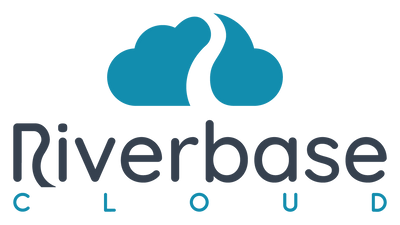Why PPC Campaign Automation Is Changing Digital Marketing
PPC campaign automation uses artificial intelligence, machine learning, and rule-based systems to automatically manage and optimize pay-per-click advertising campaigns. Instead of manually adjusting bids, keywords, and budgets, automation handles these tasks in real-time based on performance data and predefined goals.
Key Components of PPC Campaign Automation:
• Automated Bidding - AI adjusts bids based on conversion likelihood
• Dynamic Ad Creation - Automatically generates and tests ad variations
• Smart Budget Management - Reallocates spend to top-performing campaigns
• Keyword Optimization - Adds high-performers, pauses low-performers
• Audience Targeting - Uses machine learning to find ideal customers
• Performance Monitoring - Tracks metrics and sends alerts automatically
The numbers tell the story. Up to 65% of high-intent searches lead to clicks on PPC ads, making every optimization crucial. Manual campaign management consumes countless hours while often missing optimization opportunities that happen in milliseconds during ad auctions.
Businesses using automation tools can create hundreds of campaigns in minutes compared to hours with manual methods. More importantly, automated systems eliminate human error when processing large datasets - something machines excel at far better than humans.
The reality is simple: if you're managing PPC campaigns manually in 2024, you're losing out on performance gains and wasting valuable time that could be spent on strategy and creativity.
I'm Gary Gilkison, founder of Riverbase Cloud, where I've spent years developing AI-powered marketing solutions that balance automation with expert human oversight. My experience building and scaling PPC campaign automation systems has shown me that the right approach can improve ROI by 20% or more while freeing up teams to focus on high-level strategy.
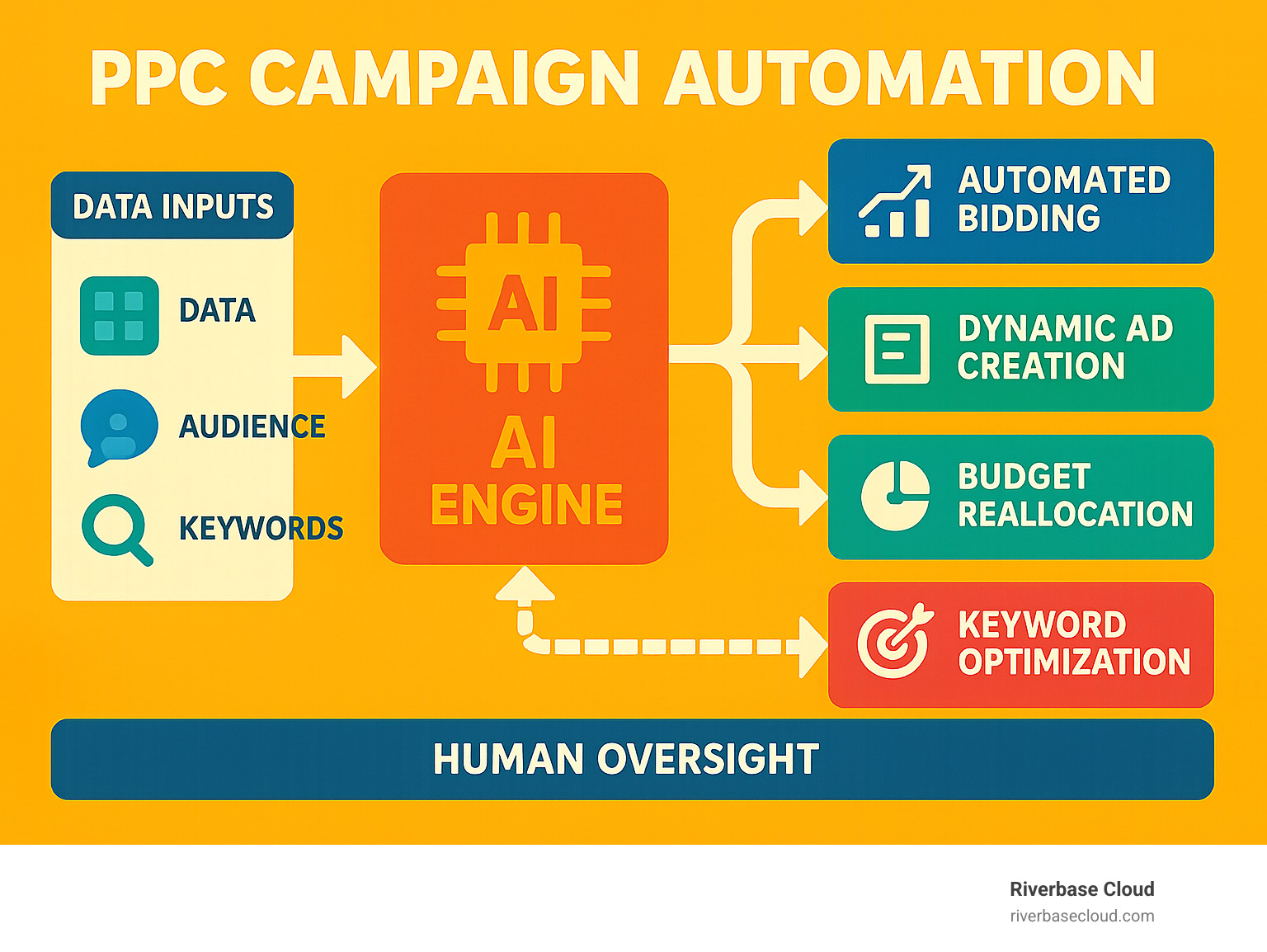
Simple PPC campaign automation word guide:
- AI-driven SEO strategies
- Google Ads AI tools
- Benefits of AI in marketing
What Is PPC Campaign Automation?
Imagine having a marketing assistant who never sleeps, never makes math errors, and can juggle thousands of decisions at once. That's essentially what PPC campaign automation delivers – technology that handles the repetitive, data-heavy tasks of managing your pay-per-click campaigns.
Instead of spending hours each day manually checking performance metrics and adjusting bids based on hunches, automation systems crunch massive amounts of data and make smart optimization decisions in real-time. It's like upgrading from a calculator to a supercomputer for your advertising efforts.
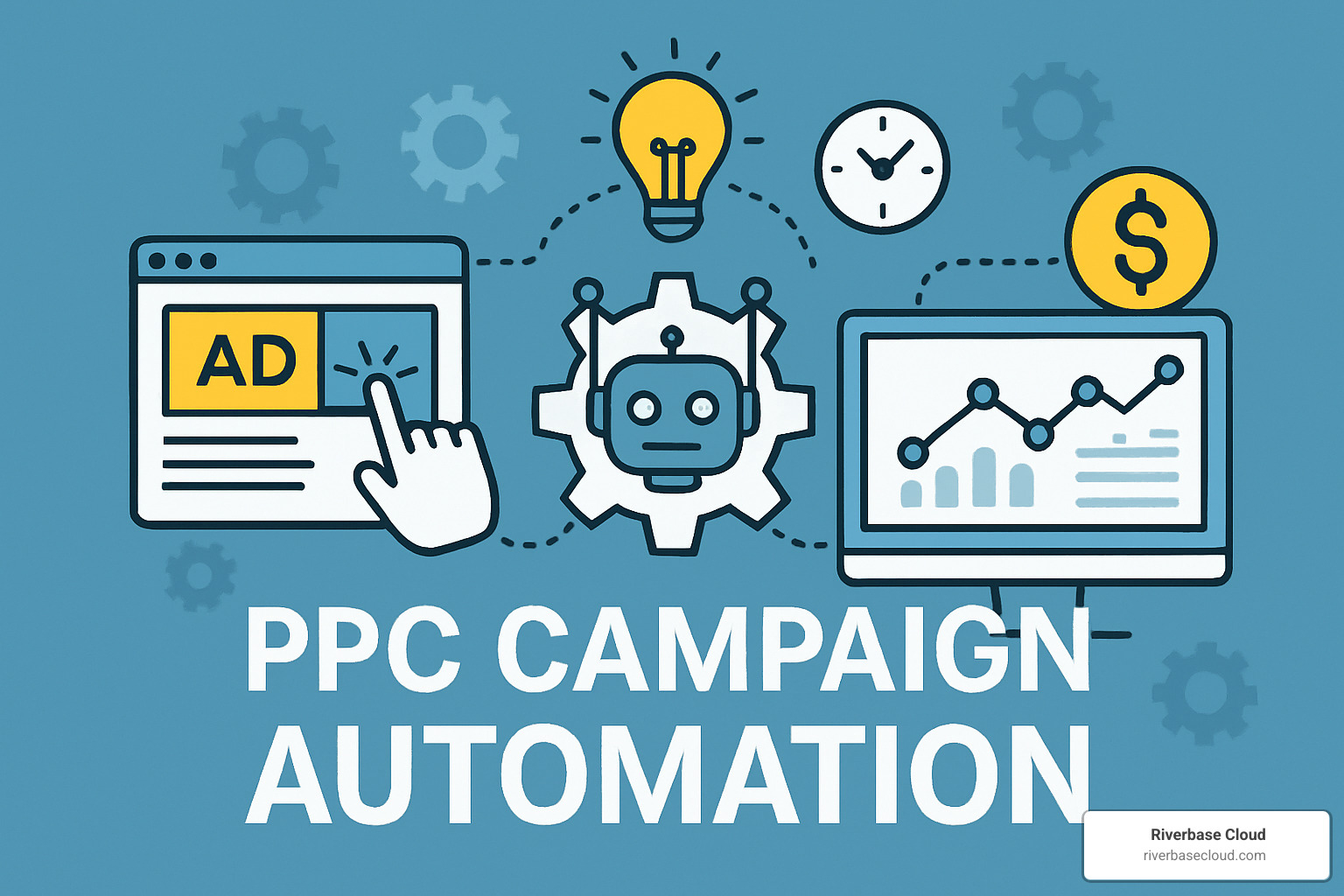
The technology behind this automation has come a long way. Early systems worked with simple if-then rules – like "if cost-per-click goes above $5, lower the bid by 20%." Today's automation uses sophisticated machine learning algorithms and automated bidding strategies that consider hundreds of real-time signals including device type, location, time of day, user behavior, and even weather patterns.
How PPC Campaign Automation Works
PPC campaign automation works like a continuous feedback loop that never stops learning and improving. The process starts with data inputs from multiple sources – your ad account performance, Google Analytics, conversion tracking, competitor activity, and external signals like seasonal trends.
The system then analyzes this information using machine learning to spot patterns and opportunities. For instance, it might find that mobile users convert 30% better on weekends, or that certain keywords perform differently across various geographic regions.
When someone searches for your target keywords, auction-time bidding kicks in. The automation system has just milliseconds to decide how much to bid, considering the searcher's device, location, search history, and dozens of other factors to determine the perfect bid amount.
Smart campaigns and dynamic search ads take this even further by automatically creating and testing ad variations based on your website content and performance data. The system continuously makes adjustments – raising bids for high-converting campaigns, pausing underperforming keywords, and even creating new ad variations to test.
Core Components of PPC Campaign Automation
Bid management serves as the backbone of most automation systems. Rather than manually setting bids and crossing your fingers, automated bid management uses historical performance data and real-time signals to optimize for your specific goals – whether that's maximizing clicks, hitting a target cost-per-acquisition, or achieving a particular return on ad spend.
Ad copy generation has become remarkably sophisticated. Modern systems automatically create headlines and descriptions based on your landing page content, test multiple variations simultaneously, and promote the winners. Some tools even adjust ad copy based on seasonal trends or what competitors are doing.
Keyword research automation works around the clock, monitoring search term reports to find new keyword opportunities and identify negative keywords that waste budget. The system can automatically add high-performing search terms and pause or exclude the money-wasters.
Performance monitoring happens 24/7, with automated alerts when campaigns stray from expected performance. Instead of finding problems during your weekly account review, you'll know within hours if something needs attention.
Landing page optimization automation can dynamically adjust page content based on where visitors come from, what device they're using, or how they behave on your site. Advanced systems even run automatic A/B tests on landing page elements to boost conversion rates.
Benefits & Best-Suited Tasks for Automation
Let me share something that might surprise you: PPC campaign automation isn't just about saving time (though you'll save plenty of that). The real magic happens when you see your campaigns performing better than ever while requiring less hands-on management.
The numbers speak for themselves. Businesses implementing automation typically see ROI improvements of 20% or more. But here's what really gets exciting - you're not trading performance for convenience. You're actually getting both.
Scalability becomes your superpower with automation. I've watched businesses go from managing a dozen campaigns to hundreds without hiring additional team members. What used to require a full day of manual work now happens automatically while you focus on strategy and growth.
Think about error reduction for a moment. We're all human, and humans make mistakes when juggling spreadsheets full of bid data at 2 PM on a Friday. Miss a decimal point in a bid adjustment? That's potentially thousands of dollars down the drain. Automated systems don't have bad days or get distracted by that urgent email from your boss.
Real-time optimization gives you a competitive edge that's hard to beat. While your competitors are sleeping, your automated system is working. It's adjusting bids based on fresh performance data, adding negative keywords to stop budget waste, and shifting money toward your best-performing campaigns.
The beauty of automation shines brightest with tasks that are repetitive, data-heavy, and time-sensitive. Bid adjustments based on performance thresholds happen instantly instead of during your weekly account review. Negative keyword harvesting from search term reports catches bad traffic before it burns through your budget. Budget reallocation between campaigns ensures your top performers always have the fuel they need.
Audience segmentation and targeting refinements become surgical in their precision. Performance reporting shifts from a manual chore to automated insights delivered right to your inbox. Ad scheduling optimizes based on actual conversion patterns rather than guesswork.
Scientific research on automated bidding strategies confirms what we see in practice: machine learning algorithms consistently outperform manual bid management, especially when there's enough conversion data to work with.
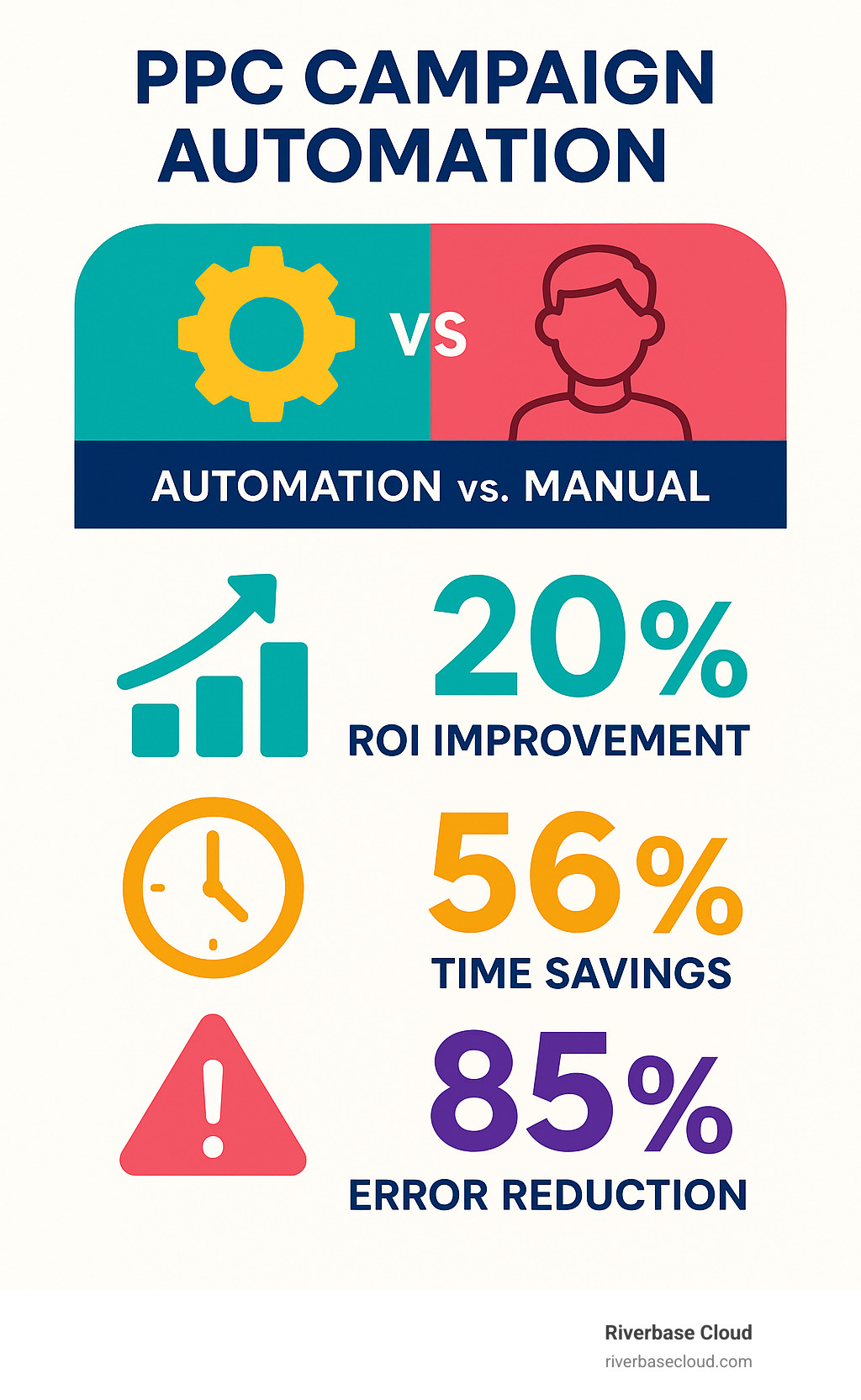
The bottom line? PPC campaign automation frees you from the tedious work so you can focus on what humans do best - creative strategy, understanding your customers, and growing your business.
Types of Automation: Rule-Based vs AI-Based
When diving into PPC campaign automation, you'll quickly find there are two main approaches: rule-based and AI-based systems. Think of it like the difference between following a recipe and having a chef who adapts based on taste as they cook.
Rule-based automation works exactly like it sounds - you set up specific rules, and the system follows them religiously. You might tell it "if my cost-per-click goes above $3, lower my bid by 20%" or "pause any keyword with less than 1% click-through rate." These systems are like having a very obedient assistant who does exactly what you ask, nothing more, nothing less.
AI-based automation takes a completely different approach. Instead of following your predetermined rules, it learns from your campaign data and makes decisions based on patterns it finds. It's like having a marketing expert who studies your account history and makes educated guesses about what will work best.
The magic often happens when you combine both approaches in a hybrid strategy. You might use rules to protect your budget (never spend more than $500 per day) while letting AI handle the complex bid optimization decisions.
| Feature | Rule-Based | AI-Based |
|---|---|---|
| Control Level | Complete control over decisions | System learns and adapts |
| Data Requirements | Works with any amount of data | Needs substantial conversion data |
| Transparency | You know exactly why decisions were made | "Black box" decision making |
| Learning Speed | No learning - follows set rules | Improves performance over time |
| Best For | Budget controls, brand safety | Complex optimization, large accounts |
When to Choose Rule-Based PPC Campaign Automation
Rule-based automation makes perfect sense when you need granular control over every decision. Maybe you're managing campaigns for a client who's very particular about brand safety, or you have strict budget constraints that can never be exceeded.
If you're working with smaller datasets - perhaps a local business with limited conversion history - rule-based systems often perform better than AI. Machine learning needs lots of data to make smart decisions, and without it, you're better off with straightforward rules.
Budget considerations also play a role here. Rule-based tools are typically much more affordable than their AI counterparts. Some are even free (like Google Ads scripts), making them perfect for businesses just starting their automation journey.
The transparency factor can't be overlooked either. When a client asks why their bid was lowered on a specific keyword, you can point to the exact rule that triggered the change. This level of clarity is invaluable for reporting and maintaining trust.
When to Choose AI-Driven PPC Campaign Automation
AI-driven automation truly shines when you're dealing with large data volumes and complex scenarios. If you're managing hundreds of campaigns with thousands of keywords, AI can spot patterns and opportunities that would take humans weeks to identify.
The predictive analytics capabilities are where AI really shows its value. Instead of just reacting to what happened yesterday, AI systems can forecast trends and adjust campaigns before problems occur. This is especially powerful for businesses with seasonal fluctuations or rapidly changing markets.
Smart bidding strategies like Target CPA and Target ROAS leverage Google's massive dataset and real-time auction signals. These systems consider hundreds of factors - device type, location, time of day, user behavior - to make bid decisions that no rule-based system could match.
Performance Max campaigns actually require AI to function properly. These campaigns automatically test different combinations of headlines, images, and audiences to find winning combinations. Without machine learning, these advanced campaign types simply wouldn't work.
The key is understanding that AI-based systems need time and data to reach their full potential. While rule-based automation works immediately, AI systems improve their performance as they gather more conversion data and learn your business patterns.
Tool Landscape & How to Select the Right Platform
Choosing the right PPC campaign automation tool can feel overwhelming. The marketplace has grown from a handful of basic scripts to hundreds of sophisticated platforms, each promising to revolutionize your advertising results. The good news? You don't need to break the bank or commit to a massive enterprise solution to see real benefits.
Start with what you already have. Google Ads' built-in automation features have become remarkably powerful over the past few years. Smart Bidding strategies, automated rules, and responsive search ads provide substantial automation capabilities without any additional cost. Microsoft Ads and other platforms offer similar native features that many advertisers overlook.
Third-party platforms enter the picture when you need capabilities that go beyond what individual ad networks provide. These tools excel at cross-platform management, advanced reporting, and sophisticated optimization rules that would take hours to implement manually. The challenge lies in finding the right balance between features and cost.
Specialized solutions have emerged for specific industries and use cases. Amazon sellers often benefit from platforms designed specifically for e-commerce automation, while local businesses might prefer tools focused on location-based targeting and call tracking.
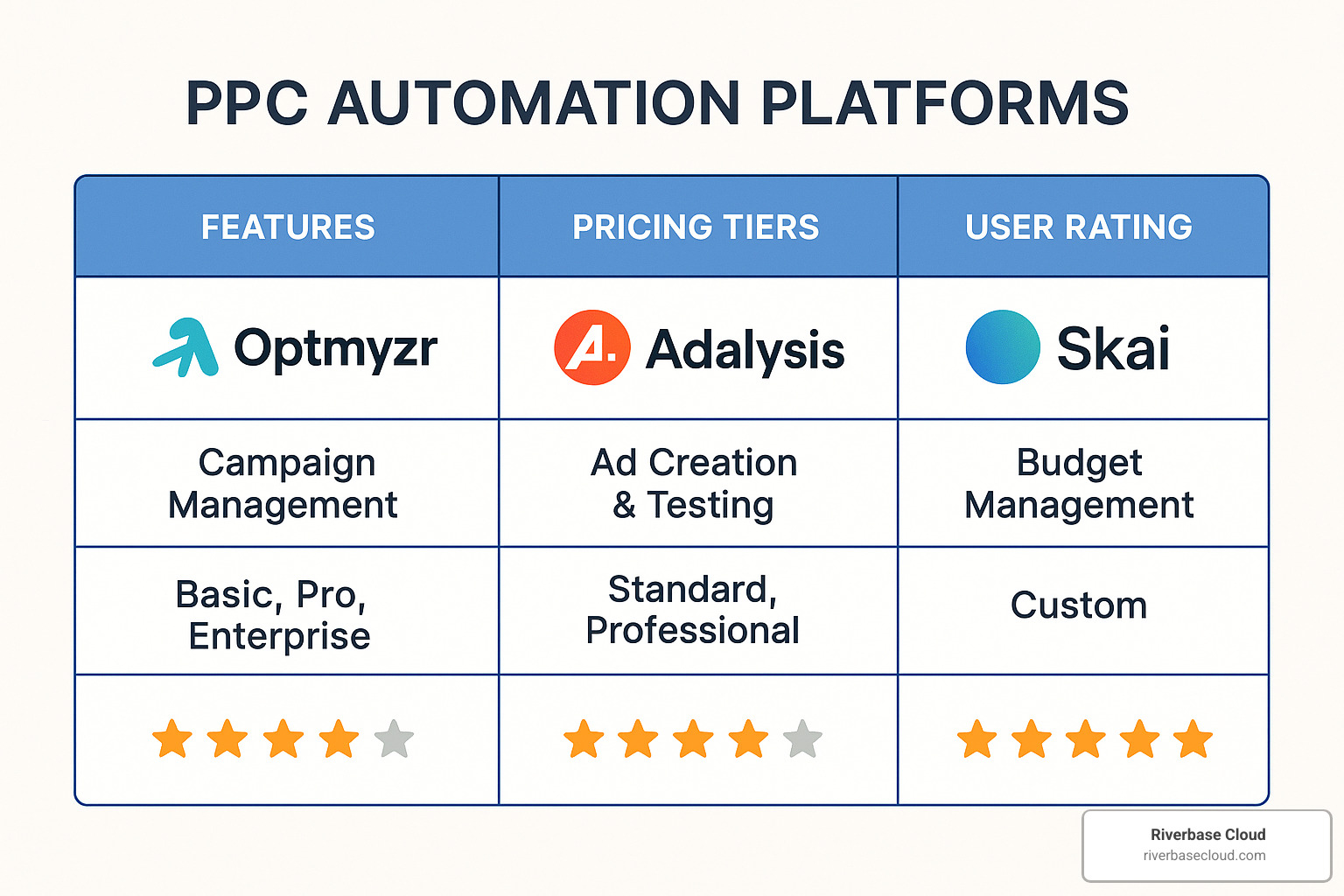
The key is understanding your specific needs before falling in love with a particular platform's marketing materials. Trial periods are your friend here - most reputable platforms offer free trials or demos that let you test functionality with your actual campaigns.
Comparing Leading PPC Automation Tools
Optmyzr has built a solid reputation around its comprehensive script library and actionable optimization recommendations. Users consistently report spending about 56% less time on routine campaign management tasks. With pricing starting around $208 monthly for $10,000 in ad spend, it sits in the sweet spot for many growing businesses. The platform particularly shines at automated bid management and catching performance issues before they become expensive problems.
Adalysis takes a different approach, focusing heavily on ad testing and quality score improvements. Their 4.8/5 rating on G2 reflects strong user satisfaction, especially among businesses that prioritize creative testing. Starting at $149 monthly for $50,000 in spend, it's become popular with agencies managing multiple client accounts. The automated A/B testing features alone can justify the cost for businesses serious about ad copy optimization.
Skai operates in a different league entirely, serving enterprise clients with budgets starting at $90,000 annually. While that price tag eliminates most small and medium businesses, it offers sophisticated cross-platform automation designed for companies managing millions in ad spend across multiple channels simultaneously.
For businesses looking to streamline your Google Ads management, starting with native Google Ads features often provides immediate benefits while you evaluate whether additional tools make financial sense.
Amazon PPC tools like Perpetua and Quartile deserve special mention for e-commerce sellers. These platforms understand the unique challenges of product advertising, including inventory management, seasonal fluctuations, and the complex relationship between organic and paid visibility on Amazon.
Google Ads Editor remains underused despite being free and incredibly powerful for bulk campaign management. While it doesn't offer AI-driven optimization, it excels at implementing large-scale changes and managing campaigns offline.
Choosing Your Perfect Fit
Your business goals should drive every decision. If you're primarily looking to save time on routine tasks, focus on platforms with strong automation and reporting dashboards. If performance optimization is your main concern, prioritize tools with advanced AI capabilities and robust testing features.
Ad spend level often determines which tools make financial sense. Platforms charging a percentage of ad spend can become prohibitively expensive for high-volume advertisers, while fixed-fee tools might strain smaller budgets. Calculate the total cost of ownership, including setup time and training, not just monthly fees.
Channel coverage becomes critical if you advertise across multiple platforms. Some tools excel at Google Ads automation but offer limited functionality for Facebook, Amazon, or LinkedIn advertising. Ensure your chosen platform supports all current and planned advertising channels to avoid managing multiple tools unnecessarily.
Support and onboarding can determine whether your automation project succeeds or fails. The most sophisticated platform becomes worthless if your team can't implement it effectively. Look for providers offering comprehensive training, responsive support, and clear documentation. Integration capabilities with your existing tools - CRM, analytics, e-commerce platforms - should also factor into your decision.
Automation tools require ongoing attention and optimization. The "set it and forget it" approach rarely works well in competitive advertising environments. Choose a platform that your team can realistically manage and optimize over time.
Implementation Roadmap & Advanced Strategies
Think of implementing PPC campaign automation like learning to drive - you wouldn't start on the highway during rush hour. The businesses that succeed with automation take a measured approach, testing carefully before going full throttle.
I've watched countless companies jump headfirst into automation, only to panic when their campaigns start behaving differently than expected. The smart approach? Start small, learn fast, and scale gradually.
Your data foundation determines everything that comes next. Before you automate a single bid, audit your conversion tracking like your budget depends on it (because it does). Test a few conversions yourself - buy something from your own site, fill out your contact form, whatever counts as a conversion for your business. Then verify those conversions show up correctly in your ads account.
Conversion tracking problems are automation killers. If your tracking is off by even a small percentage, automated bidding systems will optimize toward the wrong signals. I've seen businesses waste thousands of dollars because a tracking pixel wasn't firing properly, and the automation system thought campaigns were performing worse than they actually were.
Phased rollouts save both money and sanity. Pick one campaign - ideally one with consistent performance and decent conversion volume - and automate just that campaign first. Watch it like a hawk for two weeks. Only after you're comfortable with how automation behaves should you expand to other campaigns.
For more insights on automation implementation, our guide on Automate Your Ads provides detailed strategies for successful deployment.
Step-by-Step to Launch PPC Campaign Automation
Define your success metrics before you touch any automation settings. This isn't just about picking KPIs - it's about setting realistic expectations. If your current cost-per-acquisition is $50, don't expect automation to magically drop it to $25 overnight. Set targets that represent meaningful improvement without being fantasy goals.
Tool selection becomes much easier once you know your specific needs. Most platforms offer free trials, so take advantage of them. Spend a week actually using the tool with real campaigns rather than just watching demos. The interface that looks simple in a sales presentation might feel clunky when you're trying to set up automation rules at 9 PM.
Run controlled tests whenever possible. Create two identical campaigns - one automated, one manual - and let them run side by side for at least a month. This gives you concrete data about automation performance rather than guessing whether changes are due to automation or market conditions.
Review and adjust weekly during your first few months with automation. Automation doesn't mean "set it and forget it" - it means "set it and watch it learn." Check performance every week, look for unusual patterns, and don't hesitate to adjust targets if the system is learning in the wrong direction.
Advanced Tactics to Maximize PPC Campaign Automation
Once you've mastered basic automation, script layering opens up powerful possibilities. You might use Google's Smart Bidding for day-to-day optimization while running custom scripts that pause campaigns when your inventory runs low or increase bids during your busy season.
Dynamic Search Ads automation can feel scary at first - you're essentially letting Google create ads based on your website content. But for businesses with large product catalogs, DSAs often find profitable keywords that would take months to find manually. Start with a small budget and specific website sections until you're comfortable with how they perform.
Personalized landing pages take automation beyond the ad platform itself. When someone clicks your ad for "red running shoes," automation can show them a landing page featuring red running shoes rather than your generic homepage. These dynamic experiences typically improve conversion rates by 20% or more.
Voice search optimization is becoming critical as more people use voice assistants to search. Automation systems can adjust your keyword targeting to include more conversational phrases and question-based queries that match how people actually speak.
Feed management automation keeps your product information current across all platforms without manual updates. If you sell products online, this ensures your ads always show accurate prices, availability, and product details - crucial for maintaining customer trust and ad platform compliance.
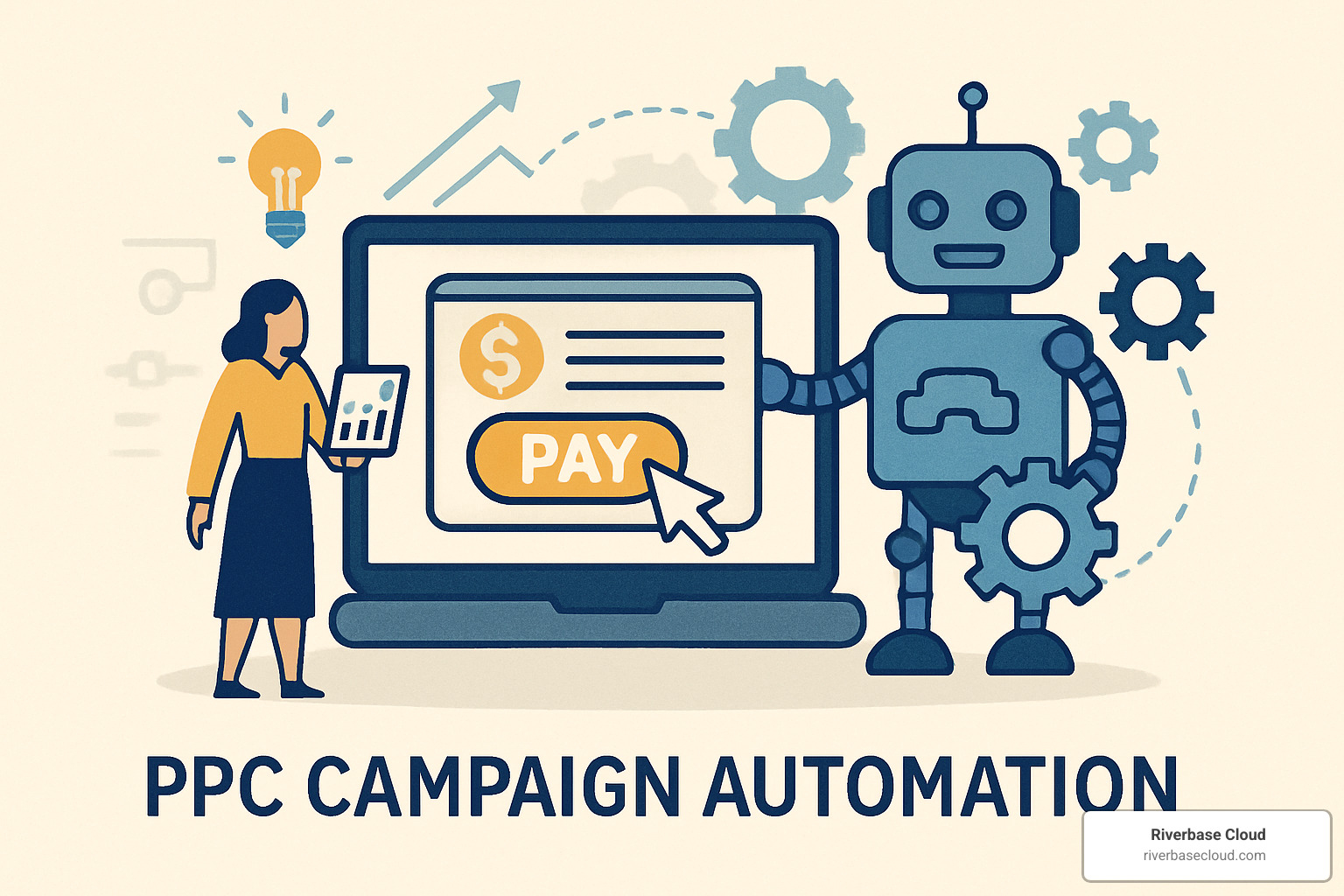
The key to advanced automation is patience. These systems need time to learn your business patterns and customer behavior. Resist the urge to make major changes during the first few weeks - let the automation gather data and find its rhythm before you start tweaking settings.
Measuring Success, Pitfalls & Balancing Human Oversight
Here's the truth about measuring PPC campaign automation success: the metrics that matter most aren't always the obvious ones. Everyone watches click-through rates and cost-per-click, but the real value shows up in how automation transforms your entire marketing operation.
Return on Ad Spend (ROAS) tells the clearest story. When we implement automation for clients, we always compare ROAS before and after - but here's the catch. You need patience. AI systems don't work magic overnight. Most platforms need 2-4 weeks to learn your patterns and hit their stride. I've seen businesses panic after a few days of mediocre performance, only to see dramatic improvements in week three.
Cost-Per-Acquisition (CPA) trends reveal whether you're actually acquiring customers more efficiently. Don't get spooked by daily fluctuations - automation systems often stumble a bit during their learning phase. Look for sustained improvements over weeks, not days.
Quality Score improvements matter more than most people realize. When automation optimizes for relevance and user experience (not just conversions), your quality scores climb. Higher quality scores mean lower costs and better ad positions - it's like getting a permanent discount on your advertising.
But here's what really gets me excited: productivity gains. Track how much time your team spends on routine campaign management before and after automation. We consistently see 50% or greater time savings. Suddenly, your team can focus on strategy and creative work instead of endless bid adjustments.
The key insight from our work on Using AI for Smarter Marketing Automation is simple: even the smartest automation needs human oversight to reach its full potential.
Avoiding Common Automation Pitfalls
Over-automation is like eating too much ice cream - it seems like a great idea until you get sick. I see businesses get so excited about automation capabilities that they flip every switch at once. Then when performance changes (and it will), they can't figure out what's helping and what's hurting.
Insufficient data kills AI systems faster than anything else. Most automated bidding strategies need at least 30 conversions in 30 days to function properly. Trying to use AI automation without enough data is like asking someone to drive blindfolded - it's not going to end well.
Black-box syndrome happens when businesses become completely dependent on automation without understanding the basics. You don't need a computer science degree, but you should understand why your automation makes certain decisions. This awareness helps you spot problems before they drain your budget.
Integration errors between platforms can corrupt your data and lead automation systems astray. I've seen conversion tracking glitches that made profitable keywords look terrible and money-wasters look amazing. Regular audits of your integrations aren't glamorous, but they're essential.
Human + Machine: The Optimal Mix
The best PPC campaign automation implementations don't replace humans - they free them up to do what humans do best. Machines excel at crunching numbers and making split-second optimization decisions. Humans provide strategic direction, creative insights, and the business context that no algorithm can understand.
Strategy development will always be a human job. Automation systems optimize toward whatever goals you set, but they can't tell you whether those goals make sense for your business. That's where human judgment becomes invaluable.
Creative development benefits enormously from human insight and brand understanding. While AI can test ad variations and identify winners, creating compelling, on-brand creative content requires human creativity and market intuition.
Automation layering - adding human oversight on top of platform automation - gives you the best of both worlds. You get machine learning efficiency with the control and transparency that real businesses need.
Team roles evolve rather than disappear. Instead of manually adjusting bids all day, your team analyzes performance trends, develops creative strategies, and identifies new market opportunities. It's more strategic, more interesting, and ultimately more valuable work.
The sweet spot isn't choosing between human or machine - it's finding the right balance for your business goals and comfort level.
Frequently Asked Questions about PPC Campaign Automation
Does PPC campaign automation replace human PPC managers?
Here's the truth: PPC campaign automation doesn't replace human managers - it makes them more valuable. Think of automation as the world's most efficient assistant that handles the tedious stuff so you can focus on what really matters.
Automation excels at the repetitive tasks that used to eat up your day. Bid adjustments every few hours? Automated. Scanning search term reports for negative keywords? Done automatically. Budget reallocation based on performance? Handled while you sleep.
But here's what automation can't do: understand your business goals, create compelling ad copy that resonates with your audience, or make strategic decisions about new market opportunities. It can't look at your data and say "Hey, we should probably create a separate campaign for that new product launch next month."
The most successful PPC managers we work with have evolved from bid adjusters to strategic thinkers. They spend their time analyzing market trends, developing creative strategies, and guiding their automation systems toward better results. It's actually a much more interesting job than manually changing bids all day.
At Riverbase Cloud, our Managed-AI approach perfectly illustrates this balance. Our AI handles the heavy lifting of optimization and routine management, while our human experts provide the strategic direction and creative oversight that drives real business growth.
How can I calculate ROI from PPC campaign automation?
Calculating your automation ROI is simpler than you might think, but you need to look at both sides of the coin: performance improvements and time savings.
Start by capturing your baseline numbers before implementing automation. Write down your current conversion rates, cost-per-acquisition, return on ad spend, and the hours your team spends on campaign management each week. These become your comparison points.
Performance ROI is the most obvious benefit to measure. If automation helps reduce your cost-per-acquisition from $50 to $40, that's a 20% improvement that flows directly to your bottom line. Similarly, if your return on ad spend increases from 400% to 500%, you're getting 25% more revenue from the same ad budget.
Time savings ROI often surprises people with its impact. Let's say automation saves your team 10 hours per week on routine campaign management. If your team's time is worth $50 per hour, that's $500 weekly or $26,000 annually in freed-up capacity. That time can be redirected to strategic work that drives even more value.
The compound effect is where things get really interesting. Better performance plus more time for strategic work often creates a snowball effect where results improve faster than either benefit alone would suggest.
Most businesses we work with see total ROI in the 150-300% range when combining performance gains with productivity improvements. The exact number depends on your starting point and how effectively you redeploy the time savings.
What budget do I need before switching to automated bidding?
The budget question isn't really about dollars - it's about data. Automated bidding systems need enough conversion information to make smart decisions, and that requires a certain volume of activity.
Google's automated bidding strategies work best with at least 30 conversions in 30 days for Target CPA bidding and 50 conversion values in 30 days for Target ROAS bidding. Without this data volume, the AI systems are essentially guessing, which rarely ends well.
Your actual budget requirement depends on your conversion rate and cost-per-click. If you're converting 2% of visitors and paying $2 per click, you'd need roughly $3,000 in monthly spend to hit that 30-conversion threshold. Higher conversion rates or lower costs mean you can start automation with smaller budgets.
Don't let budget constraints stop you from getting started. Begin with automated bidding on your highest-volume, best-performing campaigns. These typically generate more conversions and provide more stable data for the AI to learn from.
A hybrid approach works perfectly for growing businesses. Use automated bidding where you have sufficient data while maintaining manual control over brand campaigns or new product launches until they build up conversion history.
The key is starting somewhere and expanding gradually. Even automating one high-volume campaign can provide valuable insights and time savings while you build up data in other areas. Most businesses find that once they see the benefits of automation in one area, they're motivated to optimize their other campaigns to reach automation thresholds faster.
Conclusion
We've reached an inflection point in digital marketing where PPC campaign automation isn't just helpful—it's absolutely essential for staying competitive. The numbers don't lie: businesses using automation see ROI improvements of 20% or more while saving countless hours on routine tasks.
Think about where your team spends their time right now. Are they manually adjusting bids at 2 AM? Pulling reports for hours each week? Adding negative keywords one by one? All of that changes with the right automation approach.
The path forward is clearer than ever. Start with your conversion tracking—make sure it's bulletproof. Choose tools that match your budget and goals. Roll out automation gradually, one campaign at a time. Most importantly, keep humans in the driver's seat for strategy and creativity while letting machines handle the heavy lifting.
Your competitors aren't waiting around. They're already implementing smart bidding strategies, automated reporting, and AI-driven optimizations. The businesses that combine machine efficiency with human insight will capture market share from those still managing campaigns manually.
At Riverbase Cloud, we've built our Managed-AI ADS service around this exact philosophy. We use cutting-edge automation technology, but our expert team provides the strategic oversight and creative direction that makes the difference between good campaigns and great ones.
The technology will keep evolving—that's guaranteed. But the winning formula stays the same: automate the routine, amplify the strategic. Let machines process data and optimize bids while your team focuses on understanding customers, crafting compelling messages, and identifying new opportunities.
Whether you build automation capabilities in-house or partner with experts like us, the time to start is now. Every day you wait is revenue left on the table and hours wasted on tasks that could be automated.
The future of PPC belongs to businesses that automate intelligently. Make sure you're leading the charge, not playing catch-up.
